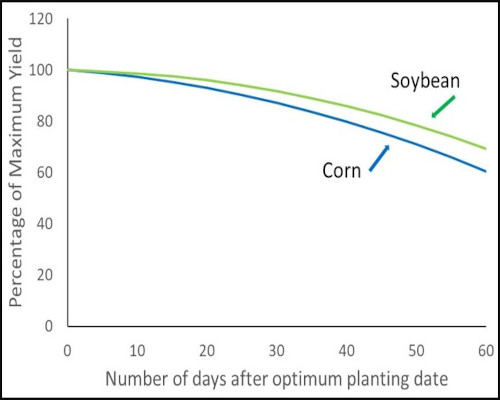Recently, there have been discussions among farmers, input dealers, and extension colleagues about planting soybean much earlier in the season than traditionally performed. In fact, some participants in those discussions have suggested that soybean could, and perhaps should, be planted before corn.
Rotations using both corn and soybean are common throughout the Midwest. Management of one component of a rotation often affects management of the other partners. Economic performance of the entire crop enterprise is more important than performance of any one component. The datasets most commonly used to recommend early soybean planting consist only of soybean yields, so the effects of delaying corn planting could not be determined. Fortunately, we have Missouri yield data for both soybean and corn collected at the same location and often in the same year. This allows us to observe the effects of planting dates on performance of the entire rotation, not just a single component.
Soybean yield data were collected in 12 experiments conducted in central Missouri at the Bradford Research Center (BRC) near Columbia. Each experiment included three, and often five, planting dates. In experiments that included five dates, the first planting date was in late March. The number of varieties varied among experiments from one to five, but were always high-yield potential, commercially available varieties. Variety maturity varied slightly, but was always between mid-MG3 and mid-MG4. Row spacing was 30 inches and seeding rate was 160,000 seeds/acre. Soybean was planted without tillage into corn residue in a soybean - corn rotation.
Corn yield data were collected over a period of six years from experiments conducted at the BRC. All corn experiments included five planting dates with the earliest planting date occurring in the last week of March. Number of hybrids varied from four to six. Hybrid maturity varied from RCMs of 106 to 114. Row spacing was 30 inches and seeding rate was 30,000 kernels/acre. Corn was planted without tillage into soybean residue in a corn - soybean rotation.
Because corn yields are much larger than soybean yields and we wanted to compare yield responses of the two crops to planting date, we calculated relative yields. Yields of each crop are presented in Figures 1 and 2 as a percentage of the largest yield for that crop within an experiment. These relative yields for each crop were averaged across all experiments and plotted on graphs.

Figure 1 Response of corn and soybean yields to planting dates relative to dates with highest yield for each crop. Data are expressed as relative yield.
Figure 1 illustrates the effect of planting date on yields starting with the date with the greatest yield. This allows us to compare rates of yield lost with delayed planting. Both corn and soybean yields are reduced by delayed planting. Corn yield decreases faster than soybean yield although the difference is not large. For example, 30 days after yields began to decrease corn yield had dropped 13% and soybean yield had deceased about 8%. The rate of yield loss with additional planting delay increased so that 10 days later yield losses were 20 and 14% for corn and soybean.